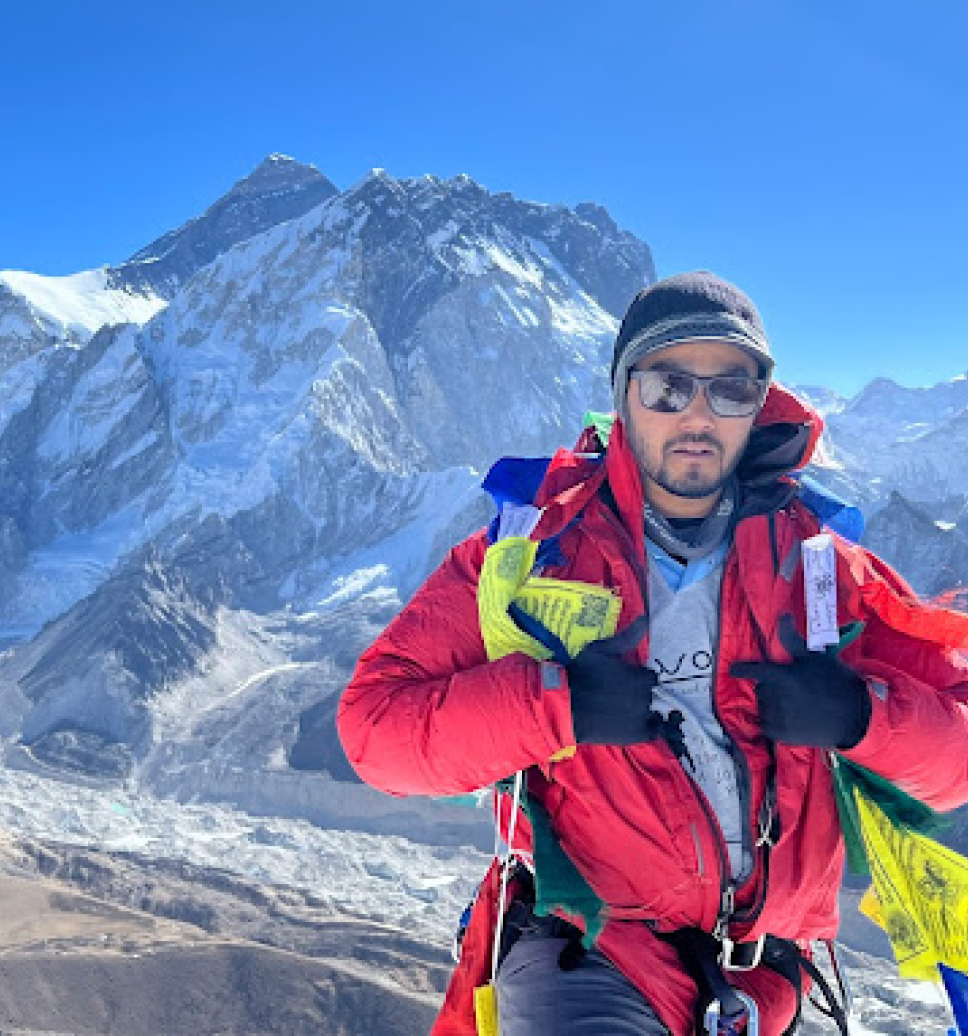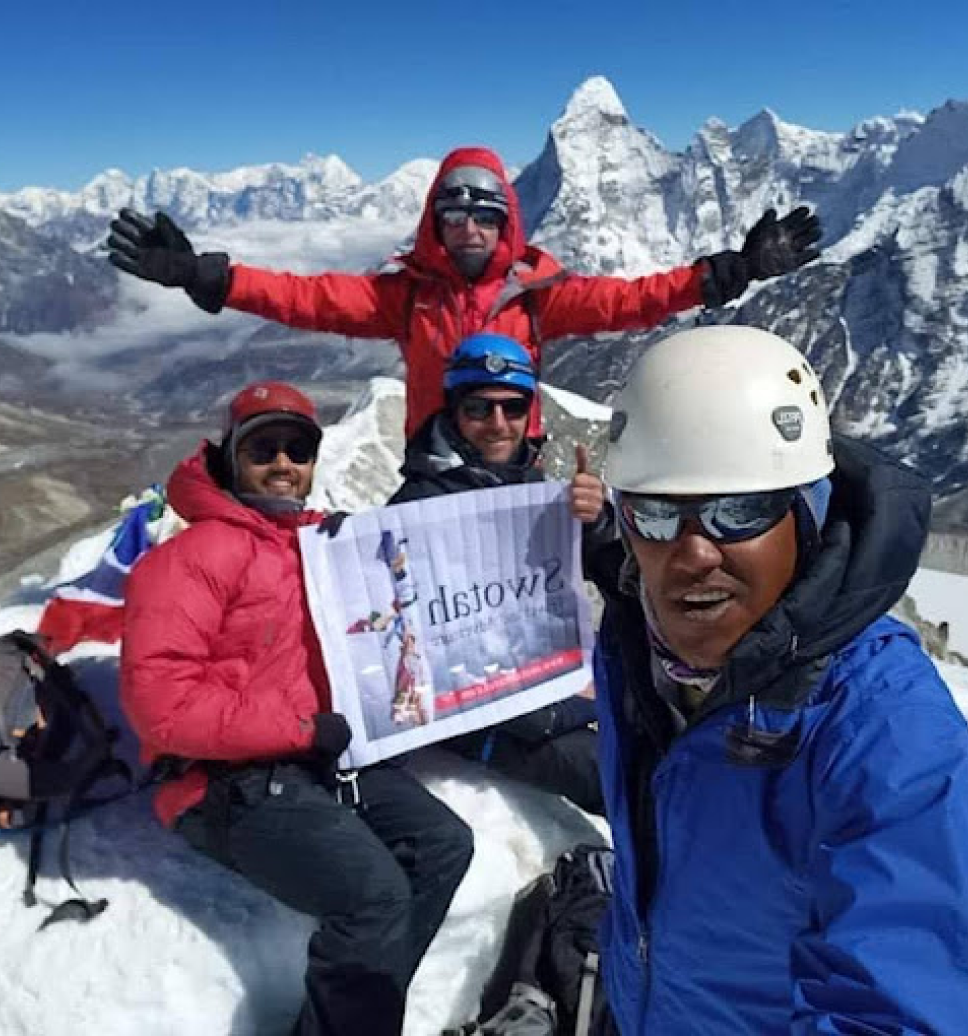GUARANTEED DEPARTURES
Check upcoming trip dates, availability & prices. If you can't see dates that suite you, contact us we will do our best to assist you.
| GUARANTEED DEPARTURES | PRICE | AVAILABILITY | |
| Mar 16, 2026 - Apr 20, 2026 | $10550 | High | |
| Apr 15, 2026 - May 20, 2026 | $10550 | High | |
| Sep 13, 2026 - Oct 18, 2026 | $10550 | High | |
| Sep 16, 2026 - Oct 20, 2026 | $9790 | High | |
| Sep 16, 2027 - Oct 20, 2027 | $9790 | High |
Trek Highlights
- Mount Pumori (7,161m) is a technically demanding climb, ideal for experienced mountaineers.
- Mount Pumori is Located on the Nepal-China border, 8.5 km west of Everest and 4.5 km from Nuptse.
- The peak was First climbed in 1962 by Gerhard Lenser on a German-Swiss expedition via the Southeast face.
- Named "Pumori," meaning "Unmarried Daughter," by English mountaineer George Mallory.
- Offers stunning panoramas of Everest, Nuptse, Rongbuk Glacier, and the Tibetan Plateau.
- Climbers face a 1,000m ice wall with gradients of 50-70 degrees, requiring advanced skills.
- The route passes through Lukla, Namche Bazaar, Tengboche, Pheriche, and Gorak Shep to Base Camp.
- Visit Tengboche Monastery, Sherpa villages, and the Hillary Museum.
- Trek through Sagarmatha National Park, home to unique flora and fauna.
- Ideal for climbers seeking to train for higher Himalayan expeditions.

Mount Pumori is an ideal peak for climbers looking to refine their technical skills, offering a challenging ascent with steep ice walls and glacial routes. Located just 8.5 km west of Everest, it provides stunning views of the world’s highest mountain and the Tibetan Plateau, making it a perfect stepping stone for future 8,000m expeditions.
Photo Gallery
Dive into our gallery to get a glimpse of the awe-inspiring vistas waiting for you on our guided treks across stunning landscapes.
Brief Itinerary
Day
1
Arrival in Kathmandu and Transfer to hotel
Day
2
Preparation, Briefings, and Permit Formalities
Day
3
Fly to Lukla and Trek to Phakding (2652m-4 Hrs.)
Day
4
Trek to Namche Bazaar (3440m)
Day
5
Rest & acclimatization, explore Everest View Hotel (3800m)
Day
6
Trek to Tengboche (3,870m)
Day
7
Trek to Dingboche (4,410m)
Day
8
Trek to Lobuche (4,940m)
Day
9
Rest and Acclimatization at Lobuche (4,940m)
Day
10
Trek to Gorakshep (5,170m)
Day
11
Trek to Pumori Base camp (5300m Hrs.)
Day
12
Day 12-28, Climbing period Summit Pumori (7 161m)
Day
29
Descend to Gorakshep (5,170m)
Day
30
Trek via Lobuche (5,218m) to Dingboche (4,410m)
Day
31
Trek to Tengboche (3,860m – 5 Hours)
Day
32
Trek to Namche Bazaar (3,440m)
Day
33
Trek to Lukla (2,840m )
Day
34
Fly from Lukla to Kathmandu and Hotel Transfer
Day
35
Contingency Day in Kathmandu and Farewell Celebration Dinner
Day
36
Transfer to the Airport for Final Departure
Comprehensive Trek Guide
Mt. Pumori, standing at an elevation of 7,161m, is one of the finest mountains for mountaineering in the Khumbu region. With its iconic pyramid shape, it is situated on the border between Nepal and Tibet and is widely regarded as the most famous 7,000-meter peak in Nepal for climbing. Pumori rewards climbers with breathtaking views of surrounding Himalayan giants, including Mount Everest and Lhotse. The name "Pumori," meaning "Unmarried Daughter," was coined by English mountaineer George Mallory, highlighting its cultural significance in the Sherpa language.
The mountain was first summited in 1962 by Gerhard Lenser and members of a German-Swiss expedition. Mt. Pumori is a challenging peak that demands prior experience in high-altitude mountaineering. While it is not the most technical climb, it requires moderate technical skills on ice and snow, making it suitable for experienced climbers.
Mount Pumori Location
Mount Pumori is located in the Mahalangur range of the Himalayas, straddling the border between Nepal and Tibet. The peak lies about 8.5 kilometres west of Mount Everest and 4.5 kilometres from Nuptse. Due to its proximity to Everest, it offers spectacular views of the world's highest mountain and the surrounding peaks. The mountain is also close to the Rongbuk Glacier in Tibet, providing a unique vantage point for climbers to experience the grandeur of the Everest region from a different perspective. The expedition passes through Sagarmatha National Park, a UNESCO World Heritage site, which is home to unique flora, fauna, and Sherpa culture.
Mount Pumori Climbing Route
The Southeast Ridge Route is the most popular and widely used path to summit Mount Pumori. This route requires climbers to navigate through technical sections of steep ice and snow, setting up multiple camps along the way. Here’s an overview of the route:
- Base Camp (5,300m/17,388ft): Located at the foot of Pumori, the base camp serves as the starting point for acclimatization and preparation. Climbers spend several days here practising climbing techniques and ensuring all equipment is in order.
- Camp I (5,700m/18,701ft): Reached by crossing glacial ice and sharp ridges, this camp marks the beginning of the technical ascent. The climb involves 40-50° slopes and some fixed rope sections.
- Camp II (6,200m/20,341ft): This camp requires ascending steep sections of snow and ice. Climbers navigate crevasses and icy bulges of up to 55°. The surrounding views of Everest and Nuptse are spectacular.
- Camp III (6,480m/21,325ft): The final staging point for the summit push. The climb from here involves traversing a 1,000m wall of glacial blue ice, with slopes ranging from 50° to 70°.
- Summit (7,161m/23,494ft): The summit offers awe-inspiring panoramic views of Everest, Lhotse, Nuptse, and the Tibetan Plateau. The climb to the summit is the most challenging part, requiring advanced technical skills and muscular physical fitness.
The return follows the same route, with time allocated at base camp and lower camps for safe descent and recovery.
Best Time to Climb Mount Pumori
The ideal seasons for climbing Mount Pumori are spring (March to May) and autumn (September to November).
- Spring (March to May): This season offers stable weather, warmer temperatures, and longer daylight hours, making it ideal for climbing. The Khumbu region’s vibrant rhododendron blooms add scenic beauty to the trek.
- Autumn (September to November): Characterized by clear skies, crisp air, and dry weather, autumn provides excellent visibility and safer climbing conditions.
Both seasons provide optimal weather for high-altitude climbing and a higher success rate for summiting Pumori.
Climbing Requirements
Mount Pumori is a demanding climb that requires prior experience with high-altitude mountaineering and technical climbing skills. Climbers should be comfortable with ropes, crampons, ice axes, and jumars, as they will be required to navigate snow-covered ridges, glaciers, and steep ice walls.
- Experience: Prior experience of climbing 6,000m or 7,000m peaks is recommended. Climbers should also be comfortable with technical ice and snow climbing.
- Fitness Level: A high level of physical fitness is crucial, as the expedition involves strenuous trekking and steep ascents at high altitudes.
- Guides and Support: Expert Sherpa guides from Swotah Travel will be available throughout the climb, providing assistance, ensuring safety, and offering technical support on the ice walls and steep sections.
Detailed Itinerary
Meals: Dinner
Accommodation: Hotel
Meals: Breakfast
Accommodation: Hotel
Meals: Breakfast,Lunch,Dinner
Accommodation: Guesthouse
Meals: Breakfast,Lunch,Dinner
Accommodation: Guesthouse
Meals: Breakfast,Lunch,Dinner
Accommodation: Guesthouse
Meals: Breakfast,Lunch,Dinner
Accommodation: Guesthouse
Meals: Breakfast,Lunch,Dinner
Accommodation: Teahouse
Meals: Breakfast,Lunch,Dinner
Accommodation: Teahouse
Meals: Breakfast,Lunch,Dinner
Accommodation: Teahouse
Meals: Breakfast, Lunch, Dinner
Accommodation: lodge
Meals: Breakfast,Lunch,Dinner
Accommodation: Camping
Meals: Breakfast,Lunch,Dinner
Accommodation: Teahouse
Meals: Breakfast,Lunch,Dinner
Accommodation: Guesthouse
Meals: Breakfast,Lunch,Dinner
Accommodation: Guesthouse
Meals: Breakfast, Luch, Dinner
Accommodation: Lodge
Meals: Breakfast,Lunch, Dinner
Accommodation: Lodge
Meals: Breakfast, Lunch, Dinner
Accommodation: Lodge
Meals: Breakfast
Accommodation: Hotel
Meals: Breakfast
Accommodation: Hotel
Meals: Breakfast
Accommodation: N/A
What's Included
- All arrival and departure transfers to and from Airport both domestic and international.
- 4 Nights 3-star category Hotel accommodations in Kathmandu on BB Plan as per itinerary.
- 1:1 experienced private climbing Sherpa guide during trek and climb.
- Flight tickets for Kathmandu-Manthali-Lukla and VV to the climbing member and his guide.
- Complete camping setup with dining & kitchen tents, chairs, and tables in Advance Base Camp.
- Necessary shower and toilet tents, individual member tents in ABC.
- One each tent for member & Sherpa sharing in Camp 1, 2, and 3.
- Solar panel/generator for light and battery charge in Advance Base Camp.
- Three meals a day (BLD, tea-coffee) and twin-sharing tea house accommodation during trek.
- Freshly cooked 3 meals (BLD), tea or coffee by Swotah professional cook in Advance Base Camp.
- Freshly cooked hot meal at Camp 2, prepared by our Camp-2 cook.
- 40 kg personal baggage while trekking up and 30 kg while down carried by porter.
- Expedition royalty and climbing permit for climbing Mt. Pumori (7,161m).
- Fully paid government-appointed liaison officer in the team.
- Necessary kitchen staff and camp manager in a sharing plan at ABC.
- Medical, accidental, and search and rescue insurance for all involved local staff.
- All rope fixing and Icefall management charges levied in the Expedition.
- Emergency oxygen mask and regulator in ABC for medical purposes only.
- Satellite phone in ABC available for members with a cost of US$ 4 per minute call.
- First Aid medical kits for the Group and the staff.
- Our service charge and Government Taxes levied in Nepal.
- Farewell Dinner in a typical Nepali restaurant with a domestic cultural show in Kathmandu.
- Swotah Special Gifts (T-shirt).
What's not Included
- Lunch and dinner during your stay in Kathmandu (except farewell dinner).
- Expenses for usage of landlines, mobiles, walkie-talkies, satellite phone, and Internet.
- Clothing, packing items or bags, personal medical kit, camera/video fees, or trekking gear.
- Climbing Sherpa Guide, high-altitude food, and tents above ABC (Camp 1, 2, 3 & 4).
- Any extra expenses arising from unforeseen situations such as natural calamities, landslides, political disturbances, strikes, or changes in government regulations.
- Any additional staff other than those specified.
- Oxygen bottles, masks, and regulators for the member.
- Rescue, medicines, medical tests, and hospitalization expenses of the member.
- Medical and travel insurance, including helicopter search and rescue.
- Permits for walkie-talkies and filming if using a special camera.
- Personal climbing gear.
- Nepal customs duty for the import of expedition goods.
- Tips to Base Camp Staff (minimum US$ 100.00 per member).
- Any other item not mentioned in the “The Package Cost Includes” section.

.jpg)




























